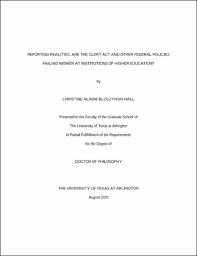
ATTENTION: The works hosted here are being migrated to a new repository that will consolidate resources, improve discoverability, and better show UTA's research impact on the global community. We will update authors as the migration progresses. Please see MavMatrix for more information.
Show simple item record
| dc.contributor.advisor | Trache, Maria | |
| dc.creator | Hall, Christine Alaine Bloczynski | |
| dc.date.accessioned | 2020-09-10T14:21:44Z | |
| dc.date.available | 2020-09-10T14:21:44Z | |
| dc.date.created | 2020-08 | |
| dc.date.issued | 2020-07-27 | |
| dc.date.submitted | August 2020 | |
| dc.identifier.uri | http://hdl.handle.net/10106/29387 | |
| dc.description.abstract | Violence against women attending institutions of higher education has been called a significant problem by both researchers and federal policymakers. The primary goal of this study was to determine if trends in the institutional reporting of forcible sex offenses and VAWA offenses reflect any changes resulting from the implementation of federal guidelines, policies, and legislation. The study also examined profiles of institutions that (1) fail to complete Clery Act reporting as federally mandated and (2) report data in a systematic way, therefore, results can be compared with the actual rates of violence against women discovered from national campus climate surveys and federally funded research studies. Finally, the study examined how specific institution and enrollment characteristics affected the number of forcible sex offenses and VAWA offenses reported.
The sample for this study included all public and private not-for-profit institutions of higher education that are mandated to report annual Clery Act crime statistics. Information on criminal offenses for 3,759 institutions (with data spanned over 17 years, 2001-2017) and information on VAWA offenses for 3,736 institutions (with data spanned over 4 years, 2014-2017) were examined.
Some of the main findings include that forcible sex offenses reporting has been on an upward trend regionally and nationally since 2009. There is also an overall upward trend nationally and regionally in the reporting of VAWA offenses. Institution characteristics, such as control, level, size, and degree of urbanization, appear to play a significant role in the average numbers of reported forcible sex offenses and VAWA offenses. All these offenses are more frequently reported when the enrollment consists of higher percentages of women, Asians, students under the age of 25, and graduate students.
Implications from the study include changes to Clery Act reporting policies, ideas for implementation of the best practice of campus climate surveys, and the call for additional federal support to institutions that appear to experience reporting challenges. | |
| dc.format.mimetype | application/pdf | |
| dc.language.iso | en_US | |
| dc.subject | Violence against women | |
| dc.subject | Forcible sex offenses | |
| dc.subject | VAWA offenses | |
| dc.subject | Crime reporting | |
| dc.subject | Higher education | |
| dc.subject | Clery Act | |
| dc.subject | Title IX | |
| dc.subject | Federal policy | |
| dc.subject | Mandates | |
| dc.subject | Compliance | |
| dc.subject | Campus climate | |
| dc.title | REPORTING REALITIES: ARE THE CLERY ACT AND OTHER FEDERAL POLICIES FAILING WOMEN AT INSTITUTIONS OF HIGHER EDUCATION? | |
| dc.type | Thesis | |
| dc.degree.department | Educational Leadership and Policy Studies | |
| dc.degree.name | Doctor of Philosophy in Educational Leadership and Policy Studies | |
| dc.date.updated | 2020-09-10T14:21:45Z | |
| thesis.degree.department | Educational Leadership and Policy Studies | |
| thesis.degree.grantor | The University of Texas at Arlington | |
| thesis.degree.level | Doctoral | |
| thesis.degree.name | Doctor of Philosophy in Educational Leadership and Policy Studies | |
| dc.type.material | text | |
| dc.creator.orcid | 0000-0003-3026-443X | |
Files in this item
- Name:
- HALL-DISSERTATION-2020.pdf
- Size:
- 1.307Mb
- Format:
- PDF
This item appears in the following Collection(s)
Show simple item record


